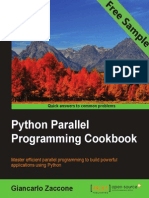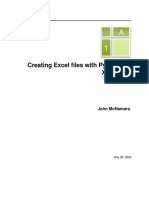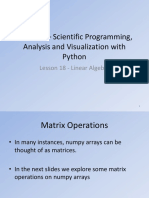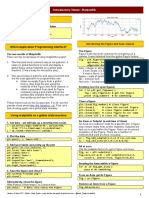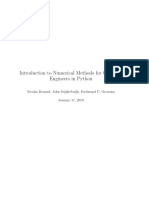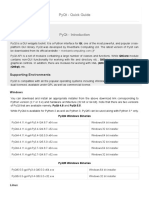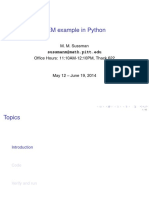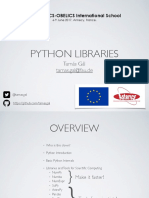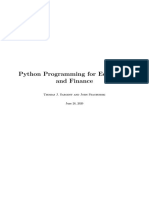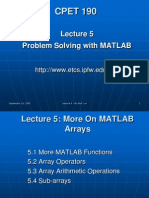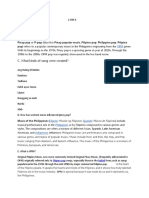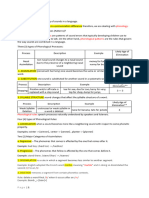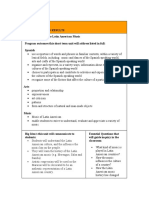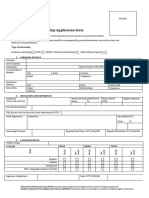Python for Science and Engineering
Dr Edward Schoeld A*STAR / Singapore Computational Sciences Club Seminar June 14, 2011
�Scientic programming in 2011
Most scientists and engineers are: programming for 50+% of their work time (and rising) self-taught programmers using inefcient programming practices using the wrong programming languages: C++, FORTRAN, C#, PHP, Java, ...
�Scientic programming needs
Rapid prototyping Efciency for computational kernels Pre-written packages! Vectors, matrices, modelling, simulations, visualisation Extensibility; web front-ends; database backends; ...
�Ed's story: How I found Python
PhD in statistical pattern recognition: 2001-2006 Needed good tools for my research! Discovered Python in 2002 after frustration with C++, Matlab, Java, Perl Contributed to NumPy and SciPy: maxent, sparse matrices, optimization, Monte Carlo, etc. Managed six releases of SciPy in 2005-6
�1. Why Python?
�Introducing Python
What is it? What is it good for? Who uses it?
�What is Python?
interpreted strongly but dynamically typed object-oriented intuitive, readable open source, free batteries included
�batteries included
Pythons standard library is: very large well-supported well-documented
�Pythons standard library
data types operating system CGI testing calendar strings compression complex numbers multimedia email networking GUI FTP databases XML threads arguments cryptography CSV les serialization
�What is an efcient programming language?
Native Python code executes 10x more slowly than C and FORTRAN
�Would you build a racing car ...
... to get to Kuala Lumpur ASAP?
�Date 1961 1984 1997 2000, Apr 2003, Aug 2007, Mar 2009, Sep
Cost per GFLOPS (US $) US $1.1 trillion US $15,000,000 US $30,000 $1000 $82 $0.42 $0.13
Technology 17 million IBM 1620s Cray X-MP Two 16-CPU clusters of Pentiums Bunyip Beowulf cluster KASY0 Ambric AM2045 ATI Radeon R800 Source: Wikipedia: FLOPS
�Unit labor cost growth
Proxy for cost of programmer time
�Efciency
When FORTRAN was invented, computer time was more expensive than programmer time. In the 1980s and 1990s that reversed.
�Efcient programming
Python code is 10x faster to write than C and FORTRAN
�What if ...
... you now need to reach Sydney?
�Advantages of Python
Easy to write Easy to maintain Great standard libraries Thriving ecosystem of third-party packages Open source
�Batteries included
Pythons standard library is: very large well supported well documented
�Pythons standard library
data types operating system CGI testing calendar strings compression complex numbers multimedia email networking GUI FTP databases XML threads arguments cryptography CSV les serialization
�Question
What is the date 177 days from now?
�Natural applications of Python
Rapid prototyping Plotting, visualisation, 3D Numerical computing Web and database programming All-purpose glue
�Python vs other languages
�Languages used at CSIRO
Python Fortran Java
Matlab IDL Perl
C C++ C#
VB.net R +5-10 others!
�Which language do I choose?
A different language for each task? A language you know? A language others in your team are using: support and help?
�Python Interpreted Powerful data input/output Great plotting General-purpose language Cost Open source Yes Yes Yes Powerful Free Yes
Matlab Yes Yes Yes Limited $$$ No
�Python Powerful Portable Standard libraries Easy to write and maintain Easy to learn Yes Yes Vast Yes Yes
C++ Yes In theory Limited No No
�Python
Fast to write Good for embedded systems, device drivers and operating systems Good for most other high-level tasks
Yes
No
No
Yes
Yes
No
Standard library
Vast
Limited
�Python Powerful, well-designed language Standard libraries Easy to learn Code brevity Easy to write and maintain Yes Vast Yes Short Yes
Java Yes Vast No Verbose Okay
�Open source
Python is open source software Benets: No vendor lock-in Cross-platform Insurance against bugs in the platform Free
�Python success stories
Computer graphics: Industrial Light & Magic Web: Google: News, Groups, Maps, Gmail Legacy system integration: AstraZeneca - collaborative drug discovery
�Python success stories (2)
Aerospace: NASA Research: universities worldwide ... Others: YouTube, Reddit, BitTorrent, Civilization IV,
�Industrial Light & Magic
Python spread from scripting to the entire production pipeline Numerous reviews since 1996: Python is still the best tool for them
�United Space Alliance
A common sentiment: We achieve immediate functioning code so much faster in Python than in any other language that its staggering. - Robin Friedrich, Senior Project Engineer
�Case study: air-trafc control
Eric Newton, Python for Critical Applications: http://
metaslash.com/brochure/ recall.html
Metaslash, Inc: 1999 to 2001 Mission-critical system for air-trafc control Replicated, fault-tolerant data storage
�Case study: air-trafc control
Python prototype -> C++ implementation -> Python again Why? C++ dependencies were buggy C++ threads, STL were not portable enough Pythons advantages over C++ More portable 75% less code: more productivity, fewer bugs
�More case studies
See http://www.python.org/about/success/ for lots more case studies and success stories
�2. The scientic Python ecosystem
�Scientic software development
Small beginnings Piecemeal growth, quirky interfaces ... Large, cumbersome systems
�NumPy
An n-dimensional array/matrix package
�NumPy
Centre of Pythons numerical computing ecosystem
�NumPy
The most fundamental tool for numerical computing in Python Fast multi-dimensional array capability
�What NumPy denes:
Two fundamental objects: 1. n-dimensional array
2. universal function
a rich set of numerical data types nearly 400 functions and methods on arrays: type conversions mathematical logical
�NumPy's features
Fast. Written in C with BLAS/LAPACK hooks. Rich set of data types Linear algebra: matrix inversion, decompositions, Discrete Fourier transforms Random number generation Trig, hypergeometric functions, etc.
�Elementwise array operations
Loops are mostly unnecessary Operate on entire arrays!
>>> a = numpy.array([20, 30, 40, 50]) >>> a < 35 array([True, True, False, False], dtype=bool) >>> b = numpy.arange(4) >>> a - b array([20, 29, 38, 47]) >>> b**2 array([0, 1, 4, 9])
�Universal functions
NumPy denes 'ufuncs' that operate on entire arrays and other sequences (hence 'universal') Example: sin()
>>> a = numpy.array([20, 30, 40, 50]) >>> c = 10 * numpy.sin(a) >>> c array([ 9.12945251, -9.88031624, 7.4511316 , -2.62374854])
�Array slicing
Arrays can be sliced and indexed powerfully:
>>> a = numpy.arange(10)**3 >>> a array([ 0, 1, 8, 27, 64, 125, 216, 343, 512, 729]) >>> a[2:5] array([ 8, 27, 64])
�Fancy indexing
Arrays can be used as indices into other arrays:
>>> a = numpy.arange(12)**2 >>> ind = numpy.array([ 1, 1, 3, 8, 5 ]) >>> a[ind] array([ 1, 1, 9, 64, 25])
�Other linear algebra features
Matrix inversion: mat(A).I Or: linalg.inv(A) Linear solvers: linalg.solve(A, x)
Pseudoinverse: linalg.pinv(A)
�What is SciPy?
A community A conference A package of scientic libraries
�Python for scientic software
Back-end: computational work Front-end: input / output, visualization, GUIs Dozens of great scientic packages exist
�Python in science (2)
NumPy: numerical / array module Matplotlib: great 2D and 3D plotting library IPython: nice interactive Python shell SciPy: set of scientic libraries: sparse matrices, signal processing, RPy: integration with the R statistical environment
�Python in science (3)
Cython: C language extensions Mayavi: 3D graphics, volumetric rendering Nitimes, Nipype: Python tools for neuroimaging SymPy: symbolic mathematics library
�Python in science (4)
VPython: easy, real-time 3D programming UCSF Chimera, PyMOL, VMD: molecular graphics PyRAF: Hubble Space Telescope interface to RAF astronomical data BioPython: computational molecular biology Natural language toolkit: symbolic + statistical NLP Physics: PyROOT
�The SciPy package
BSD-licensed software for maths, science, engineering
integration optimization interpolation FFTs clustering signal processing linear algebra ODEs n-dim image processing interpolation sparse matrices maximum entropy statistics scientic constants C/C++ and Fortran integration
�SciPy optimisation example
Fit a model to noisy data: y = a/xb sin(cx)+
�Example: tting a model with
scipy.optimize
Task: Fit a model of the form y = a/bx sin(cx)+ to noisy data. Spec: 1. Generate noisy data 2. Choose parameters (a, b, c) to minimize sum squared errors 3. Plot the data and tted model (next session)
�SciPy optimisation example
import numpy import pylab from scipy.optimize import leastsq def myfunc(params, x): (a, b, c) = params return a / (x**b) * numpy.sin(c * x) true_params = [1.5, 0.1, 2.] def f(x): return myfunc(true_params, x) def err(params, x, y): # error function return myfunc(params, x) - y
�SciPy optimisation example
# n x y y Generate noisy data to fit = 30; xmin = 0.1; xmax = 5 = numpy.linspace(xmin, xmax, n) = f(x) += numpy.rand(len(x)) * 0.2 * \ (y.max() - y.min())
v0 = [3., 1., 4.] # initial param estimate # Fitting v, success = leastsq(err, v0, args=(x, y), maxfev=10000) print 'Estimated parameters: ', v print 'True parameters: ', true_params X = numpy.linspace(xmin, xmax, 5 * n) pylab.plot(x, y, 'ro', X, myfunc(v, X)) pylab.show()
�SciPy optimisation example
Fit a model to noisy data: y = a/xb sin(cx)+
�Ingredients for this example
numpy.linspace numpy.random.rand for the noise model (uniform) scipy.optimize.leastsq
�Sparse matrix example
Construct and solve a sparse linear system
�Sparse matrices
Sparse matrices are mostly zeros. They can be symmetric or asymmetric. Sparsity patterns vary: block sparse, band matrices, ... They can be huge! Only non-zeros are stored.
�Sparse matrices in SciPy
SciPy supports seven sparse storage schemes ... and sparse solvers in Fortran.
�Sparse matrix creation
To construct a 1000x1000 lil_matrix and add values:
>>> from scipy.sparse import lil_matrix >>> from numpy.random import rand >>> from scipy.sparse.linalg import spsolve >>> >>> >>> >>> A = lil_matrix((1000, 1000)) A[0, :100] = rand(100) A[1, 100:200] = A[0, :100] A.setdiag(rand(1000))
�Solving sparse matrix systems
Now convert the matrix to CSR format and solve Ax=b:
>>> A = A.tocsr() >>> b = rand(1000) >>> x = spsolve(A, b) # Convert it to a dense matrix and solve, and check that the result is the same: >>> from numpy.linalg import solve, norm >>> x_ = solve(A.todense(), b) # Compute norm of the error: >>> err = norm(x - x_) >>> err < 1e-10 True
�Matplotlib
Great plotting package in Python Matlab-like syntax Great rendering: anti-aliasing etc. Many backends: Cairo, GTK, Cocoa, PDF Flexible output: to EPS, PS, PDF, TIFF, PNG, ...
�Matplotlib: worked examples
Search the web for 'Matplotlib gallery'
�Example: NumPy vectorization
1. Use a Monte Carlo algorithm to estimate : 1. Generate uniform random variates (x,%y) over [0, 1]. 2. Estimate from the proportion p that land in the unit circle. 2. Time two ways of doing this: 1. Using for loops 2. Using array operations (vectorized)
�3. Scaling
�HPC
High-performance computing
�Aspects to HPC
Supercomputers Parallel programming Caches, shared memory Code porting Distributed clusters / grids Scripting Job control Specialized hardware
�Python for HPC
Advantages Portability Easy scripting, glue Maintainability Proling to identify hotspots Vectorization with NumPy Disadvantages Global interpreter lock Less control than C Native loops are slow
�Large data sets
Useful Python language features: Generators, iterators Useful packages: Great HDF5 support from PyTables!
�Hierarchical data
Databases without the relational baggage
�Great interface for HDF5 data
Efcient support for massive data sets
�Applications of PyTables
aeronautics drug discovery nancial analysis climate prediction telecommunications data mining statistical analysis etc.
�Breaking news: June 2011
PyTables Pro is now being open sourced. Indexed searches for speed Merging with PyTables Working project name: NewPyTables
�PyTables performance
OPSI indexing engine speed: Querying 10 billion rows can take hundredths of a second! Target use-case: mostly read-only or append-only data
�Principles for efcient code
�Important principles
1. "Premature optimization is the root of all evil" Don't write cryptic code just to make it more efcient!
2. 1-5% of the code takes up the vast majority of the computing time! ... and it might not be the 1-5% that you think!
�Checklist for efcient code
From most to least important: 1. Check: Do you really need to make it more efcient? 2. Check: Are you using the right algorithms and data structures? 3. Check: Are you reusing pre-written libraries wherever possible? 4. Check: Which parts of the code are expensive? Measure, don't guess!
�Relative efciency gains
Exponential-order and polynomial-order speedups are possible by choosing the right algorithm for a task. These require the right data structures! These dwarf 10-25x linear-order speedups from: using lower-level languages using different language constructs.
�4. About Python Charmers
�The largest Python training provider in South-East Asia Delighted customers include:
�Most popular course topics
Python for Programmers Python for Scientists and Engineers Python for Geoscientists Python for Bioinformaticians New courses: Python for Financial Engineers Python for IT Security Professionals 4 days 3 days 3 days 4 days 4 days 4 days
�Python Charmers: Topics of expertise
Python: beginners, advanced Scientic data processing with Python Software engineering with Python Large-scale problems: HPC, huge data sets, grids Statistics and Monte Carlo problems
�Python Charmers: Topics of expertise (2)
Spatial data analysis / GIS General scripting, job control, glue GUIs with PyQt Integrating with other languages: R, C, C++, Fortran, ... Web development in Django
�How to get in touch
See PythonCharmers.com or email us at: info@pythoncharmers.com














